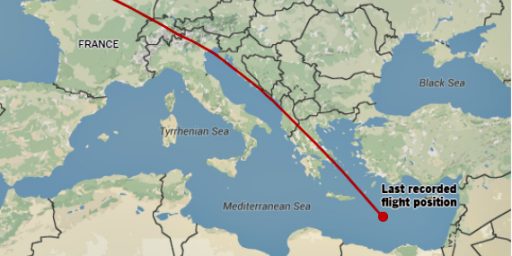Missing Plane May Not Be Where Everyone’s Been Looking
The saga of Malaysian Air Flight 370 continues to be just weird.

In just over a week, it will be three months since Malaysian Air Flight 370 went missing less than two hours into its standard run from Kuala Lumpur to Beijing. In that time, the search for the plane has become one of the most bizarre stories in recent memory, with clues sending search teams to areas vastly far apart form each other and some analysts arguing over whether the plane had flown into the northern or southern Indian Ocean. In the past month or so, though, it seemed as though searchers had narrowed the search field significantly after detecting what was thought to be signals from the plane’s data recorders. Now, though, it turns out those signals probably didn’t come from the recorders at all and that searchers may have been searching in the wrong place all along:
HONG KONG — The search area in the Indian Ocean that recovery teams have been scouring for more than a month is likely not the final resting place of a missing Malaysia Airlines jetliner, the Australian task force in charge of the operation said Thursday.
A United States Navy underwater vehicle has been searching the ocean floor in an area west of the Australian continent since early April, after thedetection of pings from what was then believed likely to be the black box recorders of Malaysia Airlines Flight 370.
The Boeing 777-200 aircraft vanished in the early hours of March 8 on a flight from the Malaysian capital of Kuala Lumpur to Beijing. Raw satellite transmission data indicated the plane had veered sharply off course and had headed south into the Indian Ocean.
“The Australian Transport Safety Bureau (ATSB) has advised that the search in the vicinity of the acoustic detections can now be considered complete and in its professional judgment, the area can now be discounted as the final resting place of MH370,” the Australian Joint Agency Coordination Centre said in a statement Thursday.
The area has been the focus of the search since April 5 when an Australian ship, the Ocean Shield, detected a signal from there emitting a frequency suggesting it was from a so-called black box that records flight data and voice transmissions. At the time, Angus Houston, a retired Australian Air Chief Marshal in charge of the operation, urged caution.
Days later, on April 9, after more signals were detected, however, Mr. Houston told reporters in Perth that “”I’m now optimistic that we will find the aircraft, or what is left of the aircraft, in the not too distant future.” No more signals were detected in subsequent weeks, consistent with the battery life span of the recorders.
Thursday’s announcement means that the search will now focus on a much larger swath of ocean than what the U.S. Navy’s Bluefin-21 submersible vehicle has searched since April. The unmanned, torpedo-shaped vehicle has searched more than 328 square miles of the ocean floor, looking for traces of the missing aircraft with its specialized sonar, the Australian statement said. Searchers are also mapping the area’s ocean floor in the area, which can be more than 15,000 feet below the water’s surface.
Now the search, which will employ private contractors, will examine a much bigger area encompassing as much as 23,166 square miles, the statement said.
An international team of experts still believes that the plane, carrying 239 people, turned sharply off course in the early morning hours of March 8, went west across Peninsular Malaysia and then out into the Indian Ocean before turning south. Data released Tuesday by the Malaysian government provided further evidence the plane headed south into the Indian Ocean and ran out of fuel. That conclusion was based on an analysis of “electronic handshakes” that the aircraft had been making with a satellite.
A spokesman from the Australian Transport Safety Bureau said an international team continues to analyze data from the satellite handshakes detected as the jet flew south over the Indian Ocean. He said the search would remain “along the arc of the seventh ping,” or the last signal picked up before the jet is thought to have hit the water, off the coast off Western Australia.
“We won’t be searching the area where the acoustic pings were detected again,” he said. “We are confident that that search has been completed. That is the zone around where the Bluefin was searching, around the signals,” the spokesman said in a telephone interview, citing government policy in declining to be identified by name.
The announcement on Thursday followed comments made to C.N.N. by a U.S. Navy official on Wednesday, who said the pings detected in early April were likely not from the flight or data recorders of missing aircraft.
At this point, the plane’s wreckage could be anywhere along the course that the last satellite signals indicate it was headed on, somewhere at the bottom of the Indian Ocean. Where to even begin the search doesn’t seem like it’s easy to figure out since there’s no way of knowing exactly how much fuel the plane had at any given point in time, or how much fuel it was burning as it traveled on its course. With enough time and the right technology, one assumes that they’d be able to find some evidence of wreckage that would lead to a more detailed search, but it’s not going to be easy. In addition to the size of the area, searchers also need to factor in the terrain of the ocean floor in the air, some of which descends to depths of thousands of feet. Potentially, even if we do find evidence of wreckage, it may end up being in an era that makes recovery essentially impossible. Finally, recovery may only end part of the mystery. The data recorders on the plane only record about two hours worth of data before writing over what’s stored and starting over again. Since the plane made its diversion from the planned course some five or six hours before the last signal was received, there may not be much information about what went wrong and whether it was mechanical or deliberate.
As hard as it is to believe, this may be a mystery that never really gets solved. And, somehow, that seems unsettling in this day and age.





It’ll just be a chapter in “Ten Mysteries of the 21st Century”, Hyperion Press, 2098
It is not hard to believe and, for me at least, there is absolutely nothing unsettling about that fact. Mystery is all around us, the things we are ignorant of far outweigh our puny knowledge of the universe. I find the hubris inherent in your statement to be far more disturbing Doug. That and the money that is being spent.
The ocean is big. Really big. You just won’t believe how vastly, hugely, mind-bogglingly big it is. I mean, you may think it’s a long way down the road to the chemist’s, but that’s peanuts to the ocean.
(With apologies to the late Douglas Adams…)
I’m not surprised we haven’t found this aircraft yet.
Well, we’re bound to find something soon. We’re squarely near the end of the fourth season of Lost in terms of in-show chronology.
@Tillman:
Didn’t Lost go on for like 18 seasons? Or did it just feel that way..
Not so much as a seat cushion. Very eery.
Considering that most long-haul flights are much, much longer than this, it seems odd to me. Why not record all data during the entire length of the flight?
@Rafer Janders: Originally, as I understand it, it was recorded on an infinite-loop tape. So when it stopped, you would have exactly the last two hours (or so), which should be enough for most purposes.
While recording technology has improved, I’d wager that the amount of data recorded has also increased tremendously over time as well.
@Jenos Idanian #13: Bill “Lindy” Gates reportedly said that 2 hours ought to be enough for anyone.
When it’s found we’ll get another round of calls for cockpit video recording and they’ll die on the vine as before as invasive or expensive.
@OzarkHillbilly: That is also my opinion. A lot of people want to ridicule and write off some unusual event, such a vortex or magnetic field anomaly. There are credible and documented cases of what we would call “mysterious” occurrences in large bodies of water. Science does not yet know all of the various forces at play here. At one time many physical events were considered scientifically impossible. Now we call this field Quantum Physics. Think about Einstein’s unified field and parallel universes. The government may be keeping a lot of this classified, and some day we may find out a lot more.
Searching for this plane should not just concentrate on the linear (up, down, forward), but also time. These are not separable.
See physicsforums.com
antiquiet.com
cnn needs this to be a story again! but seriously- there’s not many theory’s that aren’t all that plausible when you don’t have a body. the ufo one was quite the stretch but the other’s not so much.
Isn’t that kinda the definition of ‘missing’?
Future headline:”Malaysian Officials Say Missing Plane Nevet Existed After All!”